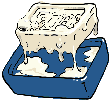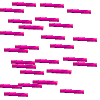Liquid Crystals
 I'll begin at the beginning, by explaining just what a liquid crystal is: it's
a substance that behaves something like a liquid and something like a solid.
If you were to touch the stuff, it would feel gooey and soapy--in fact, the
slimy mess you find at the bottom of a soap dish is a genuine liquid crystal,
not much different from the material in a laptop screen.
I'll begin at the beginning, by explaining just what a liquid crystal is: it's
a substance that behaves something like a liquid and something like a solid.
If you were to touch the stuff, it would feel gooey and soapy--in fact, the
slimy mess you find at the bottom of a soap dish is a genuine liquid crystal,
not much different from the material in a laptop screen.
|

|
 Vivid description--but I don't quite understand how something could be like
a liquid and a solid at the same time.
Vivid description--but I don't quite understand how something could be like
a liquid and a solid at the same time.
|
 Well, can you explain the difference between a liquid and a solid, in terms
of how their molecules behave?
Well, can you explain the difference between a liquid and a solid, in terms
of how their molecules behave?
|
 Sure. In a liquid, the molecules are all sort of sloshing around randomly,
with no fixed positions. In a solid, the molecules are pretty rigidly
attached to each other, and (at least in most solids) there's some kind of
regular structure, some pattern in which they're arranged.
Sure. In a liquid, the molecules are all sort of sloshing around randomly,
with no fixed positions. In a solid, the molecules are pretty rigidly
attached to each other, and (at least in most solids) there's some kind of
regular structure, some pattern in which they're arranged.
 That's exactly right. The term "crystal" refers to materials that have that
kind of ordered structure. Now, in a liquid crystal, as in an ordinary
liquid, the positions of the molecules aren't very orderly at all.
That's exactly right. The term "crystal" refers to materials that have that
kind of ordered structure. Now, in a liquid crystal, as in an ordinary
liquid, the positions of the molecules aren't very orderly at all.
 All right...so where does the crystal part come in?
All right...so where does the crystal part come in?
 What makes a liquid crystal different from ordinary liquids is the shape of
its molecules: they're long and thin, like french fries. Even if the
molecules' positions are random, their orientations can be
aligned with one another in a regular pattern--and that's what creates the
ordered structure of a liquid crystal.
What makes a liquid crystal different from ordinary liquids is the shape of
its molecules: they're long and thin, like french fries. Even if the
molecules' positions are random, their orientations can be
aligned with one another in a regular pattern--and that's what creates the
ordered structure of a liquid crystal.
|

|






